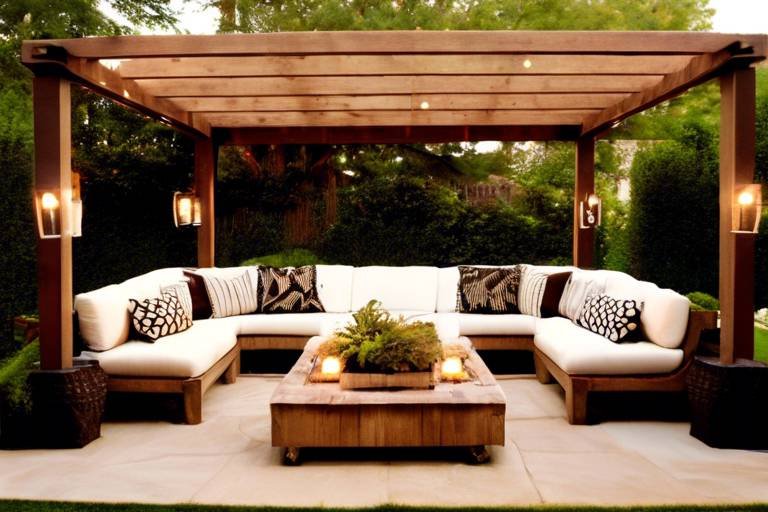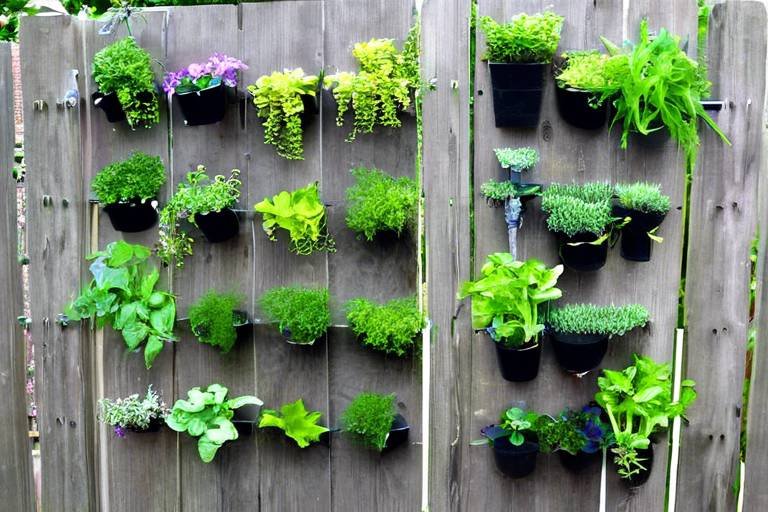How to Start a Vegetable Garden from Scratch
Starting a vegetable garden from scratch can be a rewarding and fulfilling experience. It allows you to connect with nature, grow your food, and enjoy the fresh produce right from your backyard. Whether you're a beginner or have some gardening experience, embarking on this journey requires careful planning and dedication. In this comprehensive guide, we will walk you through the essential steps to help you create a thriving vegetable garden from the ground up.

Benefits of Starting a Vegetable Garden
Starting a vegetable garden from scratch can bring a plethora of benefits beyond just the joy of watching your plants grow. One of the most significant advantages is the access to fresh, organic produce right at your fingertips. Imagine stepping outside your door and picking ripe tomatoes or crisp lettuce for your meals, knowing exactly where they came from and how they were grown.
Additionally, cultivating your vegetable garden can lead to substantial cost savings in the long run. By growing your vegetables, you can reduce your grocery bills and enjoy a sustainable source of fresh produce without relying on store-bought options. This not only saves money but also ensures that you have a constant supply of nutritious ingredients at your disposal.
Moreover, engaging in gardening activities has been linked to improved mental well-being and overall happiness. The act of tending to plants, watching them thrive under your care, and reaping the rewards of your hard work can be incredibly fulfilling and therapeutic. It provides a sense of accomplishment and connection to nature that can positively impact your mood and reduce stress levels.
Furthermore, starting a vegetable garden encourages physical activity and time spent outdoors, promoting a healthier lifestyle. Digging, planting, weeding, and harvesting all involve physical exertion that can contribute to your daily exercise routine. It's a great way to stay active, soak up some vitamin D, and enjoy the fresh air while nurturing your garden.
Lastly, there is a unique satisfaction that comes from harvesting your own food and knowing that you played a role in its growth from seed to table. The taste of a freshly picked tomato or the crunch of a homegrown cucumber can't compare to store-bought alternatives. It's a rewarding experience that connects you to the food you eat and the natural world around you.

Choosing the Right Location
When it comes to starting a vegetable garden from scratch, one of the crucial decisions you'll need to make is choosing the right location. The success of your garden largely depends on where you decide to plant your vegetables. So, what factors should you consider when selecting the perfect spot for your garden?
First and foremost, sunlight exposure plays a significant role in the growth and development of your plants. Most vegetables require at least 6-8 hours of direct sunlight daily to thrive. Therefore, opt for a location in your yard that receives ample sunlight throughout the day.
Another essential factor to keep in mind is the accessibility to a water source. Your vegetable garden will need regular watering, so it's essential to choose a location that is close to a water supply. This will make it easier for you to maintain proper hydration for your plants.
Soil quality is also a critical consideration when deciding on a location for your vegetable garden. Conduct a soil test to determine the pH level and nutrient content of the soil. Vegetables thrive in well-draining, fertile soil, so ensure that the location you choose has suitable soil conditions for plant growth.
Proximity to your home is another aspect to think about. Having your vegetable garden near your house makes it convenient for you to monitor and tend to your plants regularly. It also allows you to easily access your garden for harvesting fresh produce whenever needed.
Lastly, consider protection from strong winds when selecting the right location for your vegetable garden. Strong winds can damage young plants and affect their growth. Choose a spot that is shielded from strong gusts, either by natural barriers like trees or by creating windbreaks.

Essential Tools for Beginner Gardeners
When starting a vegetable garden from scratch, having the right tools is essential for beginner gardeners. These tools not only make the gardening process more manageable but also help ensure the success of your garden. Some of the essential tools that every beginner gardener should have include:
| Tool | Function |
|---|---|
| Trowel | Used for digging small holes for planting seeds or seedlings. |
| Garden Fork | Helps loosen and aerate the soil, making it easier for plants to grow. |
| Hand Pruners | Useful for trimming and pruning plants to promote healthy growth. |
| Watering Can | Allows for precise watering of plants without causing water wastage. |
| Gloves | Protect your hands from thorns, sharp objects, and soil while gardening. |
| Wheelbarrow | Helps transport heavy materials like soil, compost, or plants around the garden. |
These tools are fundamental for preparing the soil, planting, watering, and maintaining your vegetable garden. Investing in quality tools will not only make your gardening experience more enjoyable but also contribute to the overall health and productivity of your garden.

Preparing the Soil for Planting
When it comes to starting a vegetable garden from scratch, one of the crucial steps is preparing the soil for planting. The quality of the soil directly impacts the health and growth of your vegetables, so it's essential to get it right from the beginning. Proper soil preparation involves a series of steps to ensure that your plants have the best possible environment to thrive in.
First and foremost, it's advisable to test the soil pH before planting. This simple test can provide valuable insights into the acidity or alkalinity of your soil, allowing you to make necessary adjustments to create an optimal growing environment for your vegetables. Most vegetables prefer a slightly acidic soil pH level, typically around 6.0 to 7.0.
Adding compost or organic matter to the soil is another critical step in preparing for planting. Compost is a rich source of nutrients that can improve soil structure, fertility, and water retention. By incorporating compost into your soil, you can enhance its overall quality and provide essential nutrients for your vegetable plants to thrive.
Tilling the soil is often necessary to loosen compacted soil and create a suitable environment for root growth. This process helps improve drainage, aeration, and the penetration of water and nutrients into the soil. However, it's important not to over-till the soil, as this can disrupt the natural soil structure and beneficial organisms.
Removing weeds from the planting area is crucial to prevent competition for nutrients, water, and sunlight. Weeds can quickly overtake a garden if left unchecked, so it's essential to clear the area before planting your vegetable crops. Additionally, creating raised beds or rows can help improve drainage, prevent soil compaction, and make it easier to manage and maintain your garden.
Proper soil preparation is the foundation for a successful vegetable garden. By taking the time to test the soil pH, add compost, till the soil, remove weeds, and create raised beds, you can create an optimal growing environment for your plants to flourish and produce a bountiful harvest.

Selecting Vegetable Varieties
When it comes to selecting vegetable varieties for your garden, it's essential to consider a few key factors that can influence the success of your crops. The right choice of vegetables can make a significant difference in the yield and overall health of your garden. Factors such as your location, climate, available space, and personal preferences play a crucial role in determining which varieties will thrive in your garden.
One popular choice for many gardeners is tomatoes, known for their versatility and abundance of varieties suited to different climates. Whether you prefer cherry tomatoes for snacking or beefsteak tomatoes for slicing, there is a wide range of options to choose from. Peppers are another excellent choice, with varieties ranging from sweet bell peppers to spicy jalapenos, offering a diverse array of flavors for your culinary creations.
If you enjoy fresh salads, consider planting lettuce varieties such as romaine, butterhead, or leaf lettuce. These leafy greens are easy to grow and provide a continuous harvest throughout the growing season. Cucumbers are also a popular choice for gardeners, with varieties suited for slicing, pickling, or snacking fresh from the vine.
Carrots are a versatile root vegetable that can thrive in many garden environments. With varieties ranging in color from traditional orange to purple and yellow, carrots add visual appeal to your garden while providing a sweet and crunchy addition to your meals. Additionally, herbs like basil, parsley, and chives can complement your vegetable garden by adding flavor and deterring pests.
When selecting vegetable varieties, it's crucial to research the specific requirements of each plant, including sunlight, water, and soil preferences. By choosing a diverse selection of vegetables that suit your growing conditions, you can create a vibrant and productive garden that provides a bounty of fresh produce for you and your family to enjoy.

Planting Methods and Spacing
When it comes to planting your vegetable garden, choosing the right methods and spacing is crucial for the success of your crops. Proper planting techniques ensure that your plants have enough space to grow, access to sunlight, and adequate nutrients from the soil. Whether you are starting from seeds or seedlings, understanding the correct spacing requirements for each vegetable variety is essential.
One common method of planting vegetables is in rows, allowing for easy access between plants for maintenance and harvesting. This method works well for larger crops like tomatoes, peppers, and cucumbers. Alternatively, you can also plant in raised beds, which provide better drainage and soil aeration, ideal for root vegetables such as carrots and radishes.
When planting seeds, it's important to follow the instructions on the seed packet regarding planting depth and spacing. Some vegetables, like lettuce and spinach, can be planted closer together, while others, such as squash and pumpkins, require more space to spread out. Proper spacing prevents overcrowding, which can lead to competition for resources and stunted growth.
Using mulch around your plants not only helps retain moisture in the soil but also suppresses weeds that can compete with your vegetables for nutrients. Mulching also acts as a protective barrier, preventing soil erosion and maintaining a consistent soil temperature, promoting healthy plant growth.
Consider creating a planting plan to organize your garden layout, taking into account the mature size of each plant and their spacing requirements. Grouping together vegetables with similar water and sunlight needs can also simplify your watering and maintenance routine, ensuring that each plant receives the care it needs to thrive.

Watering and Maintenance Tips
When it comes to maintaining a healthy vegetable garden, proper watering and regular maintenance are key components to ensure your plants thrive. Watering your garden effectively and implementing necessary maintenance tasks can make a significant difference in the overall success of your vegetable growing venture.
One essential tip for watering your vegetable garden is to establish a consistent watering schedule. Different plants have varying water requirements, so it's crucial to understand the needs of each type of vegetable you are growing. Some plants may need more frequent watering, while others can thrive with less water. By monitoring the moisture level of the soil and adjusting your watering schedule accordingly, you can prevent issues such as overwatering or underwatering.
Another important aspect of watering is to pay attention to signs of plant stress caused by inadequate watering. Wilting leaves, yellowing foliage, and stunted growth are indicators that your plants may not be receiving enough water. On the other hand, soggy soil, mold growth, and root rot can signal overwatering. By observing your plants regularly, you can detect these signs early and take appropriate action to address any watering issues.
In addition to proper watering, regular maintenance tasks are essential to keep your vegetable garden in top condition. This includes fertilizing your plants to provide essential nutrients for growth and productivity. Organic fertilizers or compost can be used to enrich the soil and promote healthy plant development.
Monitoring for pests and diseases is also a crucial part of garden maintenance. Inspect your plants regularly for any signs of pest infestations, such as holes in leaves, chewed foliage, or insect eggs. By identifying pests early, you can take measures to control them using natural methods like handpicking insects, introducing beneficial insects, or using organic sprays.
Furthermore, implementing mulching in your garden can help conserve moisture, suppress weed growth, and regulate soil temperature. Mulch acts as a protective layer on the soil surface, reducing water evaporation and minimizing the need for frequent watering. Organic mulches like straw, leaves, or grass clippings can also decompose over time, enriching the soil with nutrients.
Regular weeding, pruning, and removing dead or diseased plant material are additional maintenance tasks that contribute to the overall health and productivity of your vegetable garden. By staying proactive and attentive to the needs of your plants, you can create a thriving garden that yields bountiful harvests throughout the growing season.

Natural Pest Control Methods
When it comes to protecting your vegetable garden from pests, there are several natural pest control methods that you can implement to ensure the health and productivity of your plants. These eco-friendly strategies not only help in keeping harmful insects at bay but also promote a balanced ecosystem in your garden.
One effective natural pest control method is companion planting, where certain plants are grown together to deter pests or attract beneficial insects. For example, planting marigolds alongside tomatoes can help repel nematodes, while attracting pollinators like bees.
Another approach is handpicking insects off your plants, especially larger pests like caterpillars or beetles. Regularly inspecting your garden and removing pests by hand can prevent infestations without the need for chemical pesticides.
Utilizing beneficial insects as natural predators is also a sustainable pest control method. Ladybugs, lacewings, and predatory mites are examples of beneficial insects that feed on garden pests, helping to keep their populations in check.
Organic sprays made from natural ingredients like neem oil, garlic, or hot pepper can be used to deter pests without harming beneficial insects or contaminating your produce. These homemade sprays are safe for the environment and effective against a variety of garden pests.
Implementing crop rotation is another preventive measure against pest infestations. By rotating the types of crops planted in specific areas of your garden each season, you can disrupt the life cycles of pests and reduce the likelihood of recurring infestations.
Overall, incorporating these natural pest control methods into your gardening routine can help you maintain a thriving vegetable garden without relying on harmful chemicals. By working in harmony with nature, you can protect your plants while promoting biodiversity and sustainability in your garden.
Frequently Asked Questions
- What are the benefits of starting a vegetable garden?
Starting a vegetable garden has numerous benefits, including access to fresh and organic produce, cost savings on grocery bills, engaging in physical activity, enhancing mental well-being, and the joy of harvesting your own food straight from your garden.
- How do I choose the right location for my vegetable garden?
When selecting a location for your vegetable garden, consider factors such as sunlight exposure, accessibility to a water source, soil quality, proximity to your home for easy maintenance, and protection from strong winds to ensure optimal growth for your plants.
- What tools do I need as a beginner gardener to start a vegetable garden?
Essential tools for beginner gardeners include a trowel for planting, a garden fork for soil cultivation, hand pruners for trimming, a watering can for irrigation, gloves for hand protection, and a wheelbarrow for transporting soil and plants.
- How do I prepare the soil for planting in my vegetable garden?
Soil preparation involves testing the pH levels, adding compost or organic matter for nutrients, tilling the soil to loosen it, removing weeds to prevent competition, and creating raised beds or rows to optimize plant growth and root development.
- What are some natural pest control methods for protecting my vegetable garden?
Natural pest control methods include handpicking insects off plants, introducing beneficial predators like ladybugs, practicing companion planting with pest-repelling herbs, using organic sprays such as neem oil, and rotating crops to deter pests naturally.



















